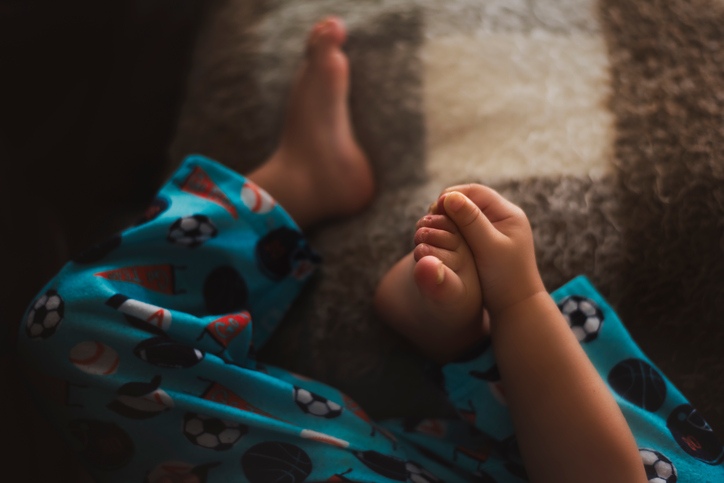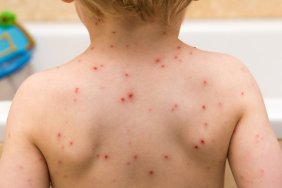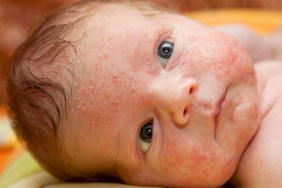When both of my babies were born I was awed by the unbelievable softness of their skin. I mean, whoever came up with that phrase, “Smooth as a baby’s bottom” was not kidding! I marveled at that delicate, creamy skin … until my son started getting these ugly, red patches along his thighs and torso. Suddenly, my buttery-soft baby was a splotchy map of sandpaper. Turns out, my sweet boy had a typical case of baby eczema. My pediatrician gave me some cream and some maintenance advice, and within days I was back to admiring my baby’s smooth skin.
The thing is, I try my best to make sure my kids are healthy but, as a mom, there’s only so much I am able to do. But sometimes it’s out of our hands. Sometimes, no matter how hard we try, our kids develop yucky looking red rashes and it’s important to get them looked at. Here’s a list of possible red rashes your baby might get, just be sure to discuss it with your pediatrician for confirmation and treatment options.
Eczema
“Eczema, also more commonly termed atopic dermatitis, effects up to one in four children and often starts around two months of age,” says Vikash Oza MD, Director of Pediatric Dermatology at New York University School of Medicine. It can most easily be spotted as dry, red, scaly patches and can show up anywhere, though parents may tend to notice it on baby’s cheeks, groin region, or trunk. As children get older, it can concentrate inside the elbows and behind the knees. Dr. Oza explains that eczema is often caused when children are born with “leaky skin” that is more porous than it should be, or could be caused by chronically inflamed skin that doesn’t function properly. Katie Friedman, MD, a pediatrician with Forever Freckled, adds that despite what you may think, bathing will not help and in fact dries babies out even more. “You want to de-crease bathing and add moisture back into the skin.” Use a greasy ointment like Vaseline or Aquaphor 2-3 times per day (especially right after a bath) to seal in moisture.
Heat rash
Also called miliaria rubra, heat rash is caused by a blockage of the sweat glands when the body is overheated, explains Dr. Oza. “This is common in the summer, with fevers or if children are over bundled.” Parents may notice this rash appearing in areas commonly covered up by clothing as a red rash with small bumps. Luckily, this type of rash usually resolves on its own within a few hours, once the stifling clothing is removed and your child is in a cooler area.
Yeast infection
“Yeast loves moist areas,” explains Dr. Friedman, and although it may at first seem like diaper rash, if this beefy red rash persists it could be a fungal infection, aka candida. Treat this type of infection with an antifungal cream, at which point it should clear up in a matter of days.
Sunburns
Dr. Oza reminds patients that an infant’s skin is thinner than an adult, and burns can be quite serious. To avoid these light pink to deep red rashes, parents must take extra care by reducing their baby’s exposure to direct or prolonged sun exposure. “Seek shade during peak UV hours 10am-4pm; use the canopy on the stroller, opt for light weight cotton longer sleeve clothing, and put on a cute, floppy wide brim hat.” Also, don’t forget sunblock on babies six months or older! Look for a physical sunscreen (rather than a chemical one) that contains zinc oxide and/or titanium dioxide.
Molluscum contagiosum
This viral skin infection, similar to warts, spreads easily and can at first look like skin-colored small bumps, but inflamed bumps can look like pinkish or red pimples. Molluscum most commonly affects preschool and elementary school age children. As a contagious infection (hence the name!), be sure wash your hands as often as possible and don’t let kids share towels, clothing, or anything that rubs the skin. “Unfortunately, there is not a tried and true home treatment that has proven to be effective,” adds Dr. Oza. However, your dermatologist may offer various office-based procedures. This infection usually goes away on its own, anywhere from a few months to two years.
Contact dermatitis
This rash usually consists of tiny, scaly blisters from the body reacting to clothing or jewelry that rubs against the skin, explains Dr. Friedman. It could be the button on your child’s jeans, or perhaps an allergic reaction to soaps or detergents. This rash should disappear on its own, but discuss topical ointments (like a mild hydrocortisone) with your doctor or dermatologist.
Roseola
Also known as sixth disease, roseola is a virus that can affect babies roughly six months to two years of age. “It causes high fever and when the fever breaks it can cause a full body rash,” explains Dr. Friedman. The fever (above 103°F) can last for a few days, and the rash that follows may look like pinkish or red dots on the trunk and can spread out along the limbs, neck, and face. Although there is no medical treatment for roseola, take your child to the doctor if you notice a consistently high fever (specific temps depend on the child, but infants should see a doctor with temps higher than 100.4°F).
Hand, foot and mouth disease
You may notice this virus as small ulcers on hands, feet, mouth, and back of the throat, and can start with lesions on the butt and groin, says Dr. Friedman. Symptoms may include fever, lethargy, and sore throat, and should clear up in a week or two. Although there is no treatment, Dr. Friedman suggests good hand washing and germ control.
Scarlet fever
This bacterial infection is associated with strep throat. Dr. Friedman explains that it may appear as a fine, sand papery type of rash throughout the face and body, could look like a sunburn, and may begin to peel, much like a sunburn. Additionally, you may notice a fever associated with the rash, and/or swollen glands and a sore throat. Although rare, scarlet fever is treatable, and requires antibiotics.
Impetigo
Impetigo can appear as red sores or honey crusted lesions that may break open and ooze, and can be caused by strep or staph bacteria, explains Dr. Friedman. Another contagious rash, be sure not to share any towels, clothing, toys, or anything else that could spread the infection. See your doctor to diagnose impetigo and receive antibiotics.
It can be hard to decide whether your baby’s rash is “bad enough” to seek expert advice, but if your child has a rash that you’re not sure of, it’s a good idea to have them evaluated. Your doctor might immediately identify the rash, or may choose to have allergy tests done. If you notice a red rash on their skin and it doesn’t go away, have it checked out and put your mind at ease.








